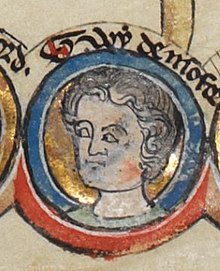Guy de Montfort, Count of Nola
Guy de Montfort | |
|---|---|
| Count of Nola | |
 | |
| Born | 1244 |
| Died | 1291 (aged 46–47) |
| Issue |
|
| Father | Simon de Montfort, 6th Earl of Leicester |
| Mother | Eleanor of England |
Guy de Montfort, Count of Nola (1244–1291) was the son of Simon de Montfort, 6th Earl of Leicester and Eleanor of England.[1]
Biography[edit]
He participated in the Battle of Evesham in August 1265 against the royalist forces of his uncle, King Henry III of England, and his cousin, Prince Edward. Both his father and elder brother Henry were killed during the disastrous battle. Guy de Montfort was seriously wounded and captured.[2]
He was held at Windsor Castle until spring 1266, when he bribed his captors and escaped to France to rejoin his exiled family. Guy and his brother, Simon the Younger, wandered across Europe for several years, eventually making their way to Italy.[2]
Guy took service with Charles of Anjou, serving as his Vicar-General in Tuscany. He distinguished himself at the Battle of Tagliacozzo and was given Nola by Charles of Anjou.
In 1271, Guy and Simon discovered that their cousin Henry of Almain (son of Richard, Earl of Cornwall) was in Viterbo at the church of San Silvestro.[3] In revenge for the deaths of their father and brother at Evesham, on 13 March 1271, Guy and Simon murdered Henry while he clutched the altar, begging for mercy. "You had no mercy for my father and brothers", was Guy's reply. This murder was carried out in the presence of the Cardinals (who were conducting a papal Election), of King Philip III of France, and of King Charles of Sicily. For this crime the Montfort brothers were excommunicated.
The news reached England, and King Henry III dispatched a clerk of the royal household to inform the northern counties and Scotland about the excommunication.[2] Pope Gregory X wrote a letter (29 November 1273) to King Edward from Lyons, where he was preparing for an ecumenical council, that Cardinal Riccardo Annibaldi and Cardinal Giovanni Orsini were still in Rome and had been ordered to find a secure place of imprisonment in the territories of the Church for Guy de Montfort.[4]
Simon died later that year at Siena, "cursed by God, a wanderer and a fugitive". Guy was stripped of his titles and took service with Charles of Anjou again, but was captured off the coast of Sicily in 1287 by the Aragonese at the Battle of the Counts. He died in a Sicilian prison.[2]
Family[edit]
In Tuscany, he married an Italian noblewoman, Margherita Aldobrandesca, the Lady of Sovana.[5] With her he had two daughters:[6] Anastasia, who married Romano Orsini,[7] and Tomasina, who married Pietro di Vico.
Cultural Reference[edit]
Dante banished Guy to the river of boiling blood in the seventh circle of his Inferno (Canto XII).
Notes[edit]
- ^ David Baldwin, Elizabeth Woodville: Mother of the Princes in the Tower, (The History Press, 2010), Genealogical table 4.
- ^ a b c d Norgate 1894.
- ^ Other sources give the site as Cathedral of S. Lorenzo in Viterbo, or the Church of S. Biagio. F. Cristofori, Il conclave del MCCLXX in Viterbo (Roma-Siena-Viterbo 1888), pp. 6-7, 56.
- ^ Thomas Rymer Foedera, Conventiones, Literae et cuiusque generis Acta Publica inter Reges Angliae et alios... editio tertia Tomus I. pars 2 (The Hague 1745), pp. 134-135.
- ^ David Baldwin, Elizabeth Woodville: Mother of the Princes in the Tower, (The History Press, 2010), Genealogical table 4.
- ^ Margherita, ward of Benedetto Cardinal Caetani, survived him and went on to be married four times more. (G. Ciacchi, Gli Aldobrandeschi nella storia e nella 'Divina Commedia' , (Rome) 1935, vol. i, ch. 6).
- ^ Napoleone Cardinal Orsini succeeded Benedetto Caetani as her mother's guardian, married her to his brother Orsello and arranged this marriage, which brought Sovana and the Aldobrandeschi inheritance to the Orsini.
Sources[edit]
- Norgate, Kate (1894). . In Lee, Sidney (ed.). Dictionary of National Biography. Vol. 38. London: Smith, Elder & Co.
- Maddicott, J.R. Simon de Montfort, 1996
- 1244 births
- 1288 deaths
- House of Montfort
- People excommunicated by the Catholic Church
- 13th-century English people
- Escapees from England and Wales detention
- English escapees
- English people who died in prison custody
- English people imprisoned abroad
- Younger sons of earls
- Prisoners who died in Aragonese detention
